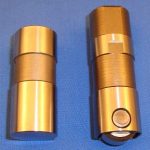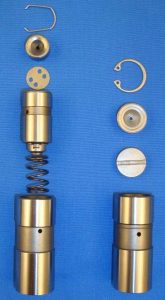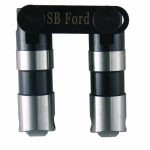Types and Designs
There are two basic lifter designs, a Flat Bottom and a Roller Lifter. The Flat Bottom lifter requires the use of a specially developed material that will endure the constant wiping pressure of the rotating cam lobe. The Roller Lifter converts that wiping force into a rolling force using a roller bearing resulting in a design that has less friction and a wider acceptance range of camshaft lobe profiles. Within both of these designs there are Hydraulic and Mechanical versions. Depending on the engine’s oiling system design, either type is capable of supplying oil to the upper valve train components.


Hydraulic Lifters have an internal piston assembly that is free to move within the outer body. This piston assembly moves to accommodate thermal growth and component wear to keep a net zero lash in the valve train. Once adjusted to the prescribed preload these usually never have to be adjusted again over the life of the engine.
Mechanical Lifters have no internal moving parts and have Zero effective loss in Camshaft Lobe Lift. This type of lifter requires there to be some initial valve lash to allow for thermal growth in the valve train. This valve lash will change over the life of the engine and usually has to be readjusted to maintain the correct amount designated by the engine manufacture.
Retro-Fit Hydraulic Roller Lifters are engineered specifically for early flat tappet engine blocks and features vertical bar design for pre-hydraulic roller lifter blocks

Types of Hydraulic Lifters:
Hydraulic Lifters are great for a maintenance free valve train but do have some limitations. In some performance applications where higher valve spring pressure is required, a standard Hydraulic Lifter might not be able to handle the extra spring load resulting with the piston collapsing. The collapsing will cause a loss in valve lift and usually a ticking noise. We have three different types of Hydraulic Lifters to accommodate a wider range of performance requirements.
OEM Design: These parts don’t have any designation after their part number. So a standard part number will look like A-0817. These Lifters are manufactured to be direct replacements of the Original equipment. They have the same range of Leak Down as was supplied to your car manufacture. These lifters are made with the widest Leak Down range of 10 to 120 seconds. The reason for this range is to ease manufacturing and reduce the cost of the part. We manufacture this type of parts to the same range as was supplied to the OEM with 90% of them being in the 20 to 80 second range.
“R” or Race Design: These parts have an “R” designation after their part number. So a Race Design part number will look like A-0817R. These Lifters have a Leak Down on the lower end of the scale from 8 to 20 seconds. In the performance application these lifter will actually “Bleed” down and result in an effective loss of valve lift and duration at lower RPMs. These are also referred to as “Variable Duration” Lifters and will supply a better idle quality when using a performance cam while still getting the benefit of the upper end power over a stock cam. As the engine increases in RPM the Bleed down effect is reduced resulting in more duration and valve lift. Having lifters with a much smaller Leak Down range will also balance all of the cylinders to each other. Having one cylinder with lifters having a Leak Down of 80 seconds will react and produce a different power curve than the same cylinder with a 10 second Lifter.
“S” or Slow Design: These parts have an “S” designation after their part number. So a Slow Design part number will look like A-0817S. These Lifters have a Leak Down on the upper end of the scale from 90 to 120 seconds. In a performance application these lifter will actually act like a mechanical lifter with very little effective loss of valve lift or duration at any RPM. Just like the “R” Lifters these have a much smaller Leak Down range that will also balance all of the cylinders to each other. These lifters are very hard to produce because the TOTAL clearance between the I.D. of the Body and the Piston assembly is reduced to less than 0.000120”, or 1/30 of a human hair. These are like super heavy duty shocks and can handle higher spring pressures without collapsing like the standard and “R” lifters. The only draw back of this type of lifter is that if the valve train should “Float” because of reaching a higher RPM than the valve springs can handle these lifters will try to take up the excessive clearance causing the valve to hang open resulting in a loss of power. Because these are Hydraulic lifters there is no lash or additional adjustment needed and the full cam profile is translated to the valves. In testing, not only did these lifters result in more power and higher RPM reading over other Hydraulic lifters they also reduced valve train wear and failure compared to mechanical lifters.
